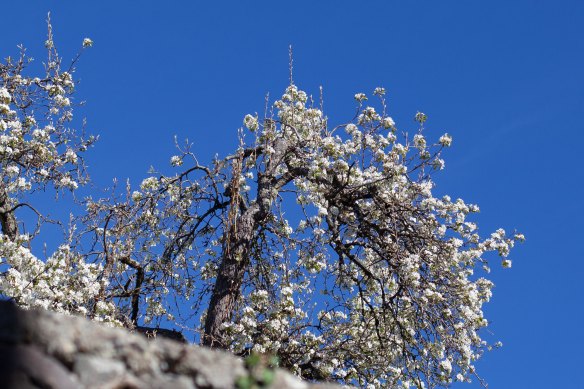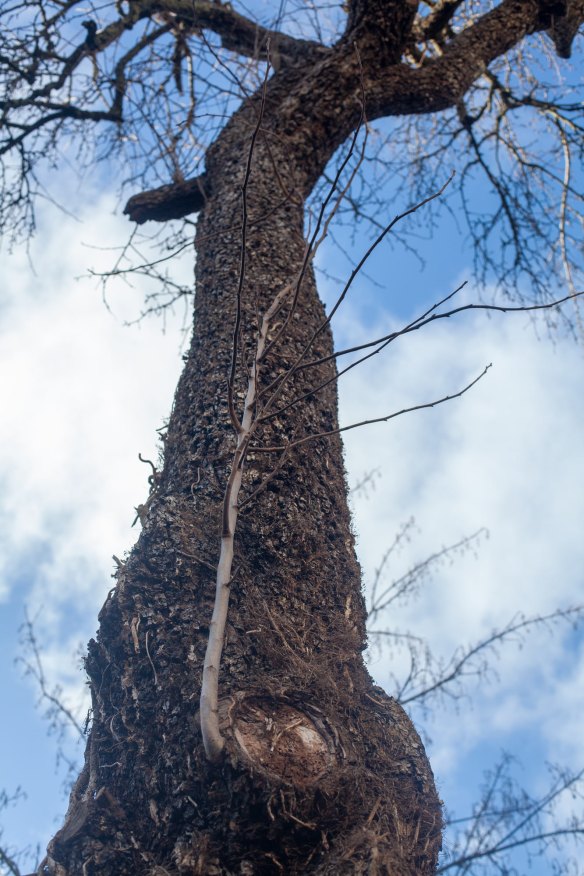 In the fourth part of this series on the life expectancy of fruit trees, we come back to Aurillac to celebrate the memory of a remarkable twelve-metre tall pear tree felled on 11 March 2020 in the town centre. To start with, let’s look at the steps which led to its downfall.
In the fourth part of this series on the life expectancy of fruit trees, we come back to Aurillac to celebrate the memory of a remarkable twelve-metre tall pear tree felled on 11 March 2020 in the town centre. To start with, let’s look at the steps which led to its downfall.
________________________________________
The heavy pruning of a centenary pear tree in the centre of Aurillac is the fourth experience of 2018 that inspired this series. From that moment, I knew the tree was in danger. I was unfortunately right. It was felled in March 2020 to allow for the construction of a house. What led to the downfall of this remarkable tree?
According to the family who owned the place for more than a century, the once five-storey high fruit tree, located on a small green space adjacent to their house, was planted between 1850 and 1870. It was therefore at least one hundred and fifty years old. This also was the estimate of the Association des Croqueurs de pommes du Cantal1, experts of heritage fruit varieties, who told me about its existence in 2016.
It must have been well looked after, as it safely went through the intense urbanisation that took place in the borough after the train arrived in Aurillac in 1866. Times changed though. The pear tree, respected thus far and perhaps considered as valuable for its productive function or because it was a living witness of a long strand of local history and the people who inhabited it, lost favour with its owners and local authorities in the 2000s.
A new generation of heirs sold the house, but kept ownership of the garden where the tree was growing. This coincided with a move by local urban planners to implement a national housing densification policy. In 2013, the plot lost its protected garden status in the council’s housing plan, opening the way for construction.
The fate of the pear tree, located on too small a parcel for a new building to be constructed without cutting it down, was not sealed yet. The centre of Aurillac is a “site patrimonial remarquable”2 (remarkable heritage site) subject to another set of urban rules aimed at protecting and enhancing its patrimonial assets, including green spaces. In November 2016, the garden was listed under those rules, which meant that it was forbidden to build on the parcel. As this set of rules prevails in case of inconsistencies with the council’s plan, the garden was safe, in principle. The pear tree itself was not though, as it was not listed as a protected tree. A landlord could fell it without having to ask for permission. This is exactly what happened in March 2020.
The tree had already been damaged. Low branches were cut off close to the trunk during garden maintenance interventions. Then, from 2013 onwards, the garden was left unmaintained. Ivy, brambles and other weeds started to grow. Soon, this green space became a wild piece of land covered in meters of vegetation, something understandably considered as a nuisance in a town centre.
Following a request from the council, the place was cleared-up in 2018. Unfortunately the pear tree was heavily pruned at the same time. Large branches were cut off as well as the top of its crown. I saw the tree before and after. The difference was so noticeable that it looked as if it had been mistreated. During the 2018 hot summer a branch loaded with fruit broke. Had the pruning weakened the tree?
I wondered whether this pear tree had become an inconvenience. Why were some of its main branches cut off, which stripped away its splendour? It seems there was no need for that, as the tree was not blocking light to the windows of the surrounding flats, located more than ten metres away from the tree, and the branches were not overhanging the street.
One can wonder whether the tree needed to be cut back because of its old age, for the sake of its health. After all, it was heading towards two hundred years of age; it would have been wise to treat it with special care. However, I observed what happened after the 2018 pruning. The tree reacted by producing ‘watershoots’ at the top of its crown, which are ‘vigorous, tall, upright and leafy branches, producing no flowers or fruit.’3. It is a sign of a vigorous tree recreating a balance of roots and leaves lost through excessive pruning, not of a weak one that needed to be downsized to survive.

A year after the 2018 pruning. Vigorous watershoots can be spotted in particular on the trunk just below where it was cut back. Photo 8 April 2019.

As for lower branches, the pear tree was trying to grow new ones. The quality of the wood of this three meter or so young shoot suggests the old tree had a good vitality. Photo 12 February 2020.
Was the tree pruned by a qualified arborist with an expertise in fruit trees? Probably not. Did the landlords and local authorities consider whether this tree deserved to be preserved? I doubt it. Anyway, if they thought it should be protected and cared for, the idea was not followed through, or in a rather counterproductive way, as the tree is not there anymore.
The fatal blow occurred at the beginning of 2020. In February, a request for a building permit was submitted to the city council. Were the new owners of the garden aware of the legal constraint attached to the parcel, which prevents from building a house? Was that constraint lifted? Whatever the case, a few weeks later the tree was felled.
Whether the house will be built or not remains to be seen. As for the tree, it is dead. This monument to nature’s generosity and living memory of the men and women who planted it in the middle of the nineteenth century, probably connected to the even older history of a convent, had definitely become an inconvenience to be got rid off.
In my view, it’s a shame. Tall pear trees of this kind can live for hundreds of years and it is in our interest to protect them. They not only embody our cultural capital, but they also are our companions of fate. We share the same living space. Can’t we learn something from them?
The following chapters of this story will explore our relationship with these tall fruit trees which live longer than us and their contributions to our lives. It will be my way of celebrating this remarkable pear tree now defunct, so that others might live longer. If you know any stories about old fruit trees with more auspicious endings, please get in touch!
- https://croqueurs-national.fr/en/ (accessed 30 April 2020).
- https://www.culture.gouv.fr/Sites-thematiques/Monuments-historiques-Sites-patrimoniaux-remarquables/Presentation/Les-sites-patrimoniaux-remarquables
(in French, automatic translation into English accessible from the site, accessed 30 April 2020). - https://www.rhs.org.uk/advice/profile?pid=279 (accessed 30 April 2020).







Thank you for the post it really is so sad to see the unnecessary butchering of such a magnificent tree.
‘A pear tree is blooming by a collapsed house on a battlefield’
Masaoka Shiki
‘As was the custom in such cases, the pear tree was charged with murder and sentenced to be uprooted and burned’.
Robert Graves
If anyone had a doubt about the vigour of this old tree, here is a picture taken yesterday of a root offspring sprouting from its stomp.
